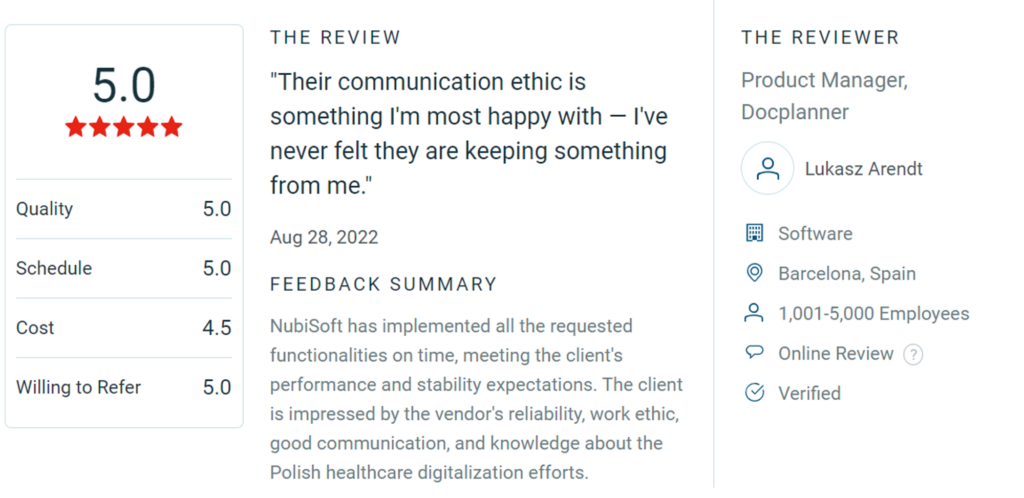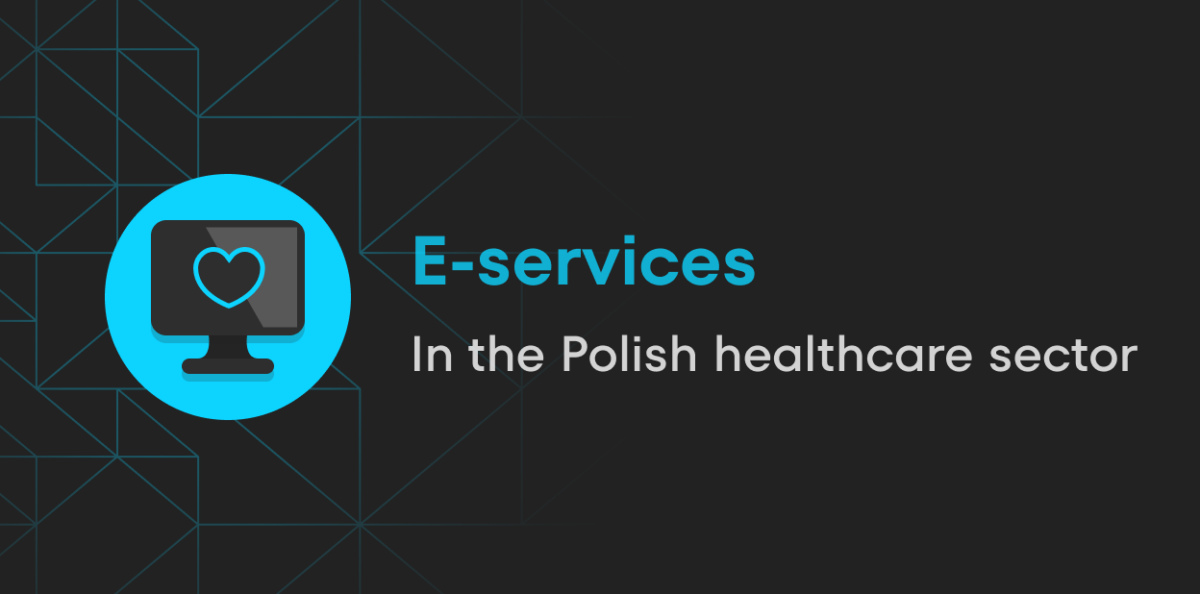The informatization of Poland’s health sector is an ongoing process, but a number of tools and services have already been made available to improve the efficiency, availability, and quality of health services provided. The biggest such innovation is the P1 platform introduced by the e-Health Center (CeZ), i.e., the Electronic Platform for Gathering, Analysis, and Sharing of Digital Resources on Medical Events, within which e-services have been made available: e-prescription, e-sick leave, e-referral, e-call, e-medical documentation (EMD), e-blood, and an Internet Patient Account (IKP).
It should be mentioned that the use of some resources made available by CeZ is obligatory (legally regulated by relevant ministerial decrees) for all entities performing medical activities – regardless of their source of financing. Given this, all hospitals, outpatient clinics, specialized clinics, and even individual practices face the need to invest in IT infrastructure that would enable them to function within this ecosystem and use e-services in their daily work. Companies offering custom software development and having ready-made solutions to make the use of CeZ tools easy and seamless have responded to this demand.
What e-services must medical facilities in Poland use?
E-Prescription
E-prescription is a digital version of prescriptions previously issued in paper form. As of January 8, 2020, prescriptions are compulsorily issued in electronic form. Issuing it takes less time than writing it out manually and has a lower risk of error. It is also more convenient from the perspective of the patient, who can always access his e-prescriptions from the Internet Patient Account. An e-prescription contains information about the prescribed drug, including dosage, quantity, and expiration date.
How does the e-prescription work?
- A doctor who uses an IT system integrated with the P1 platform can generate e-prescriptions for patients; Each prescription must be signed by the doctor with an electronic signature (Social Security certificate, trusted profile, personal signature in e-Personal ID or qualified signature).
- The patient receives the e-prescription in the form of:
- SMS with a 4-digit access code, and/or
- e-mail with e-prescription information attached in PDF, or/and
- notification/code in the myIKP app
- information printout.
- A prescription issued in this way can be filled by the patient at any pharmacy where the pharmacist, through the P1 platform, will have access to all information about the prescribed drug.
- Information about the dispensed drug is stored in the P1 system, which allows the patient’s treatment history to be tracked.
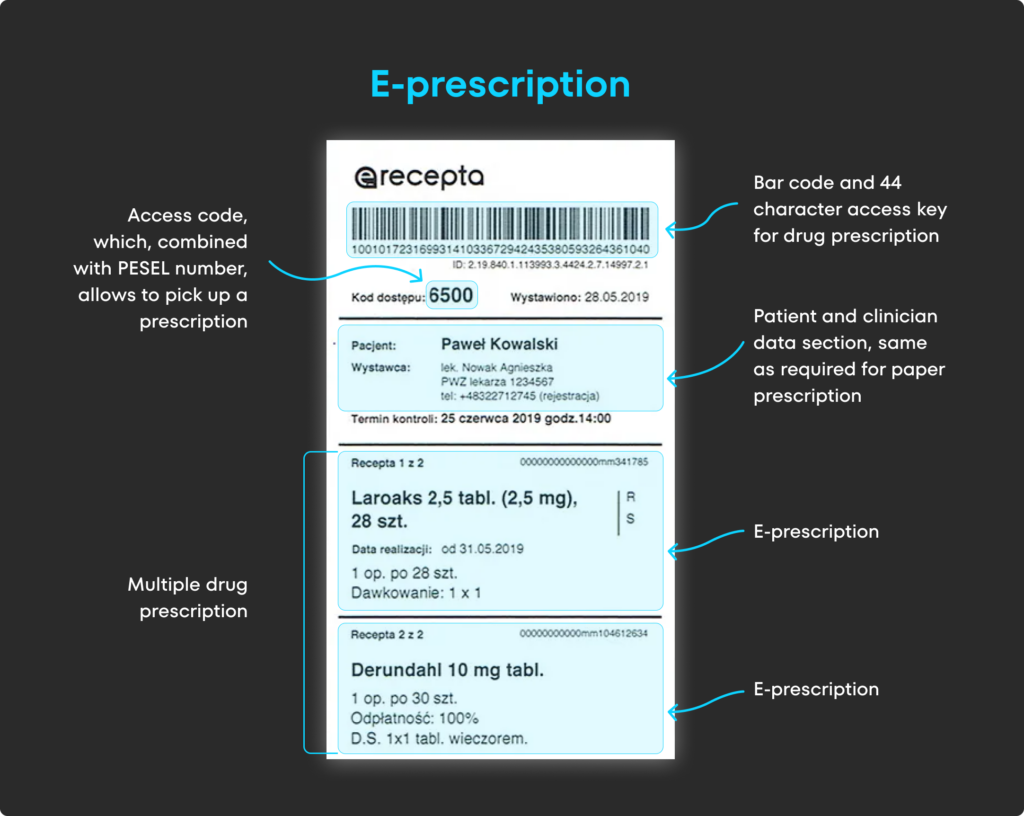
E-Referral
Like e-prescription, e-referral is an electronic version of the paper referrals that once existed. As of January 8, 2021, the digital form has become a common form of such documents. As a result, the patient does not have to worry about losing the physical document, and the registrant, based on a PIN, gets access to all the necessary information, minimizing the risk of errors related to its transmission.
How does e-referral work?
- A healthcare professional generates an e-referral, which is signed electronically.
- The P1 system verifies the referral while generating a 4-digit identification code.
- The patient receives an SMS message containing a PIN, which, together with his or her PESEL number, he or she transmits to the selected medical facility, which is the preferred place of delivery of the health service.
- The medical facility transmits the obtained information to the P1 system, which automatically verifies the patient’s data. After positive verification, the patient is scheduled for an appointment.
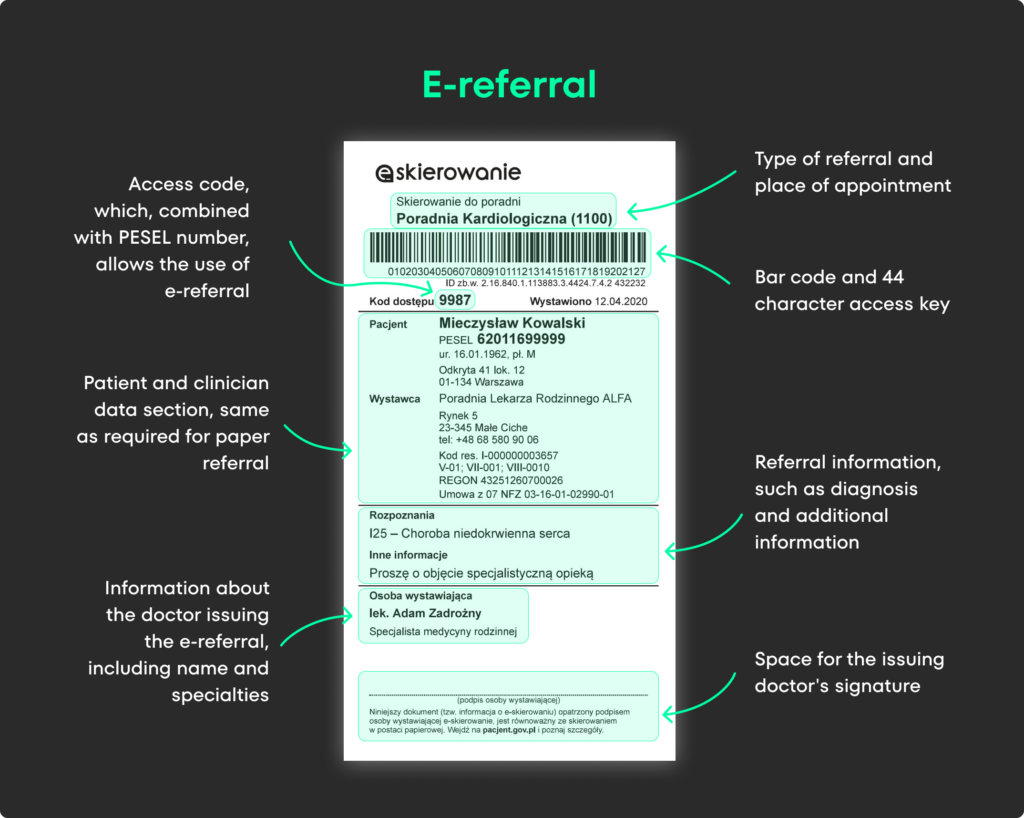
E-Sick Leave
Since September 1, 2018, e-sick leave (e-ZLA) has completely replaced the paper version of the previous ZUS ZLA document. As a result of the introduction of this e-service, the exemption issued by a doctor, or medical assistant, is automatically delivered to the Social Insurance Institution (ZUS) and the employer. As a result, the employee does not have to do it himself. It is also done instantly, reducing fraud or errors. In addition, the time and paperwork involved in issuing exemptions have been significantly reduced, thanks to the automatic retrieval of patient data from the PESEL database. The option to issue exemptions using mobile devices such as tablets has also been introduced.
The procedure for issuing an e-ZLA is as follows:
- The doctor creates an e-ZLA, signing it with the appropriate certificate (PUE ZUS, qualified electronic signature, ePUAP, e-certificate);
- The certificate is transferred to the ZUS e-services platform;
- ZUS makes the e-certificate (e-ZLA) available to the premium payer (employer) and the insured (employee) via the PUE ZUS profile, no later than the next business day.
With the new legal requirement for using this sick leave form, there was a lot of interest in the medical community for a tool to make issuing e-certificates easier. One of the first tools available to the public was e-ZLApka, a web-based app we created. It lets doctors issue e-ZLA effortlessly using a device with internet access and a web browser. To confirm someone is a licensed doctor allowed to issue electronic sick leave, they need to provide a ZUS Certificate, which also acts as a digital signature for the e-document.
The functionality we have produced is available at: https://ezlapka.pl/.
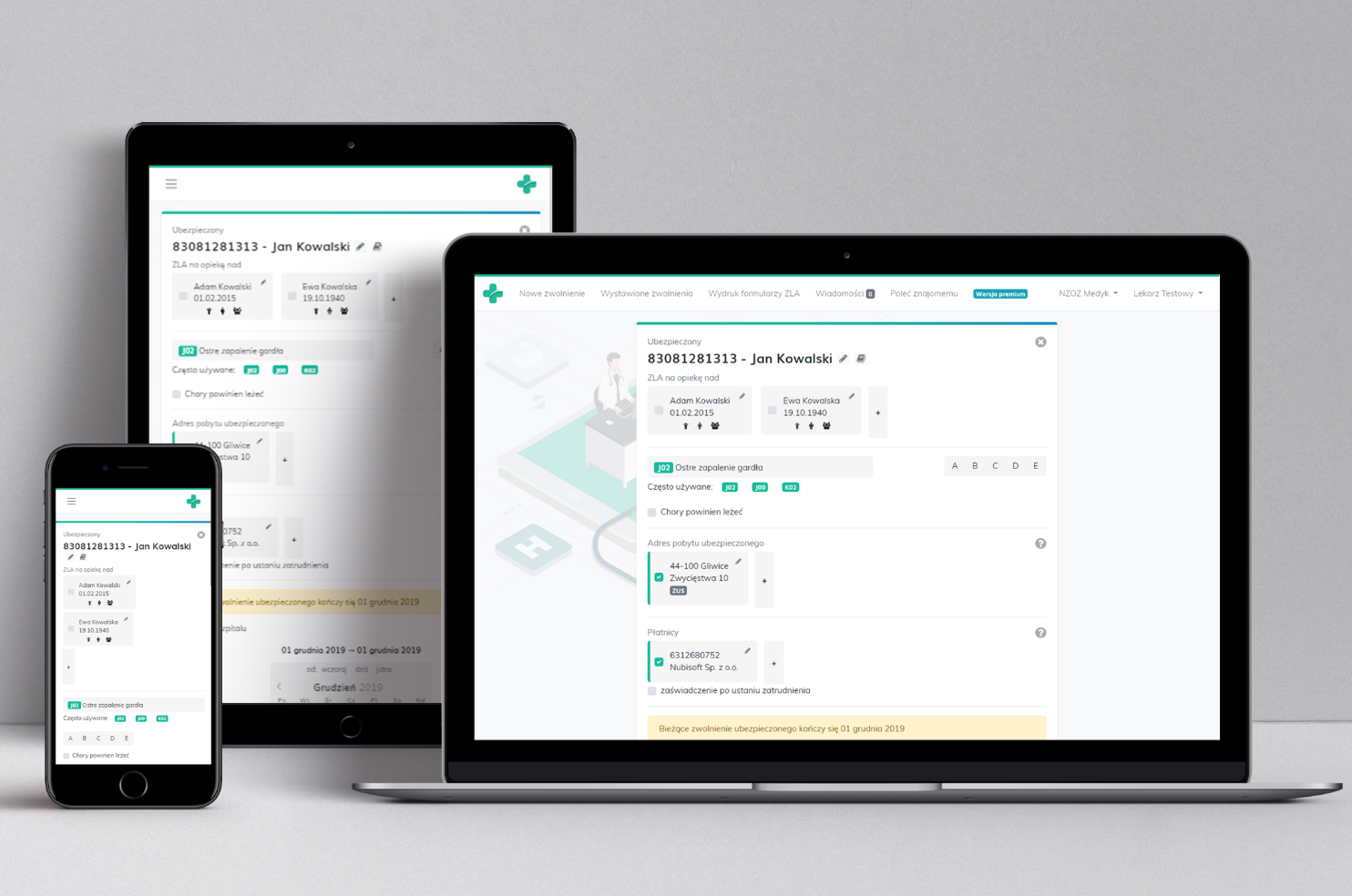
Electronic Medical Documentation (EMD) and Medical Events
As of January 2019, all entities conducting medical activities are required to maintain and exchange electronic medical records (EMD) and report so-called Medical Events to the P1 platform.
What the concept of EMD encompasses is regulated by the provisions of the Act of April 28, 2011, on the health care information system (Journal of Laws 2011 No. 113, item 657). These include information about a diagnosed disease, identified injury, e-prescriptions, e-referrals, e-sick leaves, information sheet from hospital treatment, and laboratory test results with description. The aforementioned information must be stored electronically in the HL7 CDA international standard. The uniform format results in easier data management and enables data exchange between facilities. An electronic signature to guarantee the reliability of the information is also required to produce the EMD.
The obligation to send reports on Medical Events (MEs) was introduced on July 1, 2022. A Medical Event is otherwise a health care service, that is, according to the same law of April 28, 2011:
An action aimed at prevention, preservation, rescue, restoration, or improvement of health, and other medical action resulting from the process of treatment or separate regulations governing their provision.
The MEs report must contain information about the service provider (doctor or other medical professional), the service recipient (patient), the location (information about the facility), and the service itself (what procedures were performed, what documentation was created).
The appropriate level of security should also be remembered. By law, medical records are the responsibility of the healthcare provider. Although the Ministry does not provide penalties at this time for failure to comply with the regulations on the maintenance of EMD, if they fail to maintain them reliably, for example, if the data were lost or fell into the wrong hands, then the facility must expect severe consequences:
- up to 500 thousand zlotys in fines from the National Health Service (NFZ) and probable termination of the contract,
- payment of compensation or damages to patients due to violation of their patient rights;
- civil liability for causing property or non-property damage as a result of violations of data protection regulations;
- the financial penalty imposed by the UODO;
- criminal liability under the provisions of the Criminal Code in extreme cases.
Polish e-health market
The above-mentioned legal regulations, as well as the demands of patients themselves, have forced medical facilities to take steps to adapt to the new standards. Many IT solutions have appeared on the market to support the operation of medical facilities, which provide synchronization with the P1 platform and the use of e-services. An example is ZnanyLekarz (en. Docplanner) – the largest platform in Poland for making patient appointments with doctors. This company also offers a program for the practice (ZnanyLekarzPRO), in which the ability to issue e-prescriptions, e-prescriptions, or e-referrals is a basic and one of the most important functionalities.
Our team was responsible for integrating this solution with the Polish e-services of the P1 platform and institutions such as ZUS, EWUŚ and IKP. Thanks to this cooperation, the system now efficiently manages numerous patients while complying with strict medical regulations, including in the area of data security.
If you are looking for specialists to efficiently integrate your software with the national systems (P1) of the e-Health Center and NFZ, ZUS – make an appointment for a no-obligation meeting, during which we will jointly consider the possibilities for cooperation.
A more extensive overview of this collaboration can be found on our profile on Clutch: here.
